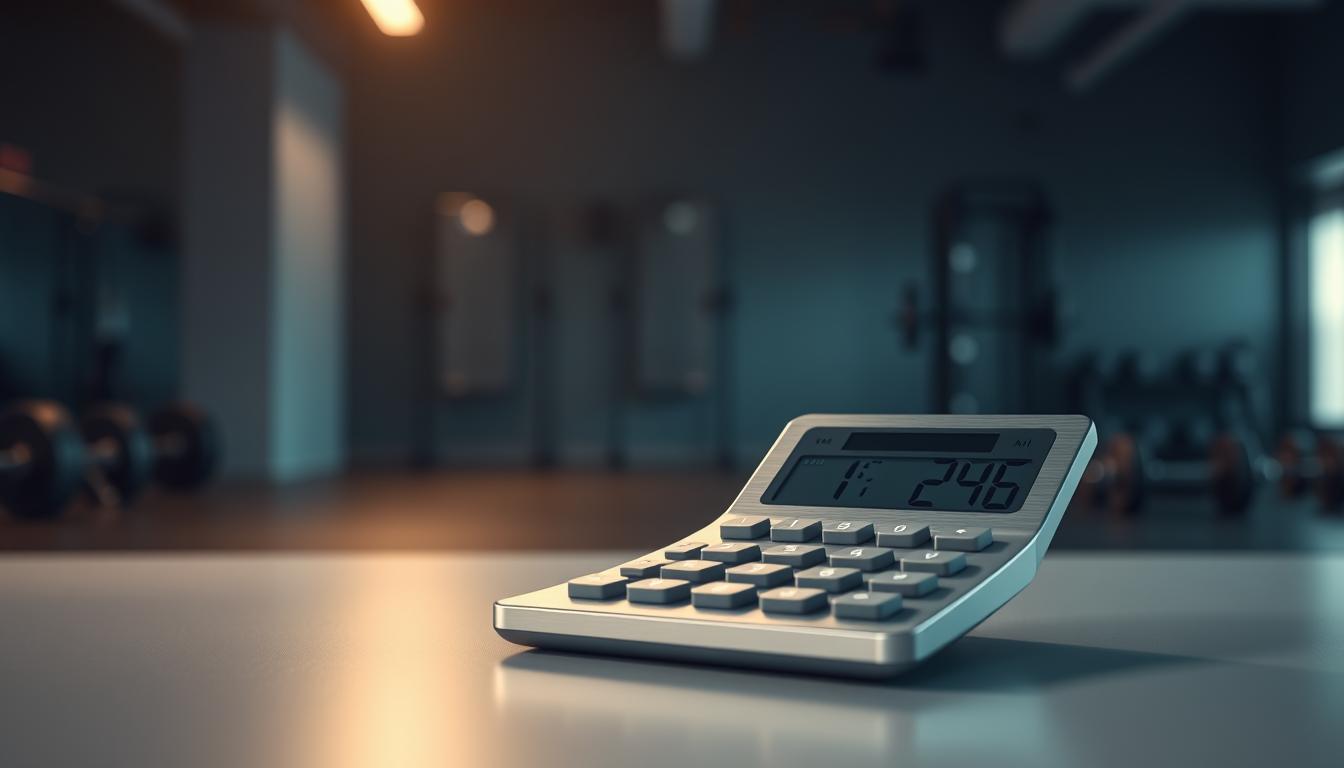“The last three or four reps is what makes the muscle grow. This area of pain divides a champion from someone who is not a champion.” – Arnold Schwarzenegger. This powerful quote encapsulates the essence of strength training and its impact on our body and overall fitness.
Understanding the energy expenditure during strength training is crucial for achieving fitness goals, whether it’s weight loss, muscle building, or overall health improvement. Our Weight Lifting Calorie Burn Calculator is designed to provide accurate estimates based on scientific principles and metabolic research.
By using our calculator, users can gain insights into the calories burned during various weight lifting activities. This comprehensive guide will walk you through the science behind calorie burn, factors affecting energy expenditure, and tips to maximize results.
Key Takeaways
- Accurate estimates of calories burned during strength training sessions.
- Understanding the science behind calorie burn and energy expenditure.
- Factors affecting calorie burn during weight lifting activities.
- Tips to maximize calorie burn and achieve fitness goals.
- The importance of strength training for overall fitness and health.
Understanding Calories and Energy Expenditure
Calories are a measure of energy, and comprehending how our body uses and expends this energy is vital for anyone looking to improve their fitness through exercises like weight lifting. The process of burning calories is intricately linked with our body’s energy expenditure, which is influenced by our metabolic rate, the type and intensity of exercise we perform, and our overall body composition.
What Are Calories?
Calories are units of energy that our bodies use to function, from basic metabolic processes to physical activity. The energy from the food we consume is measured in calories, which are then utilized by our body for various physiological processes.
Why Tracking Calories Matters for Fitness
Tracking calories is crucial for fitness because it helps individuals understand how much energy they are expending versus how much they are consuming. This balance is key to achieving fitness goals, whether it’s losing weight, gaining muscle, or maintaining overall health.
The Science Behind Calorie Burn
The human body utilizes different energy systems (phosphagen, glycolytic, and oxidative) depending on the type and intensity of exercise. During physical activity, our metabolic rate increases, leading to a higher rate of calorie burn. Moreover, the concept of excess post-exercise oxygen consumption (EPOC) plays a significant role in continued calorie burn after exercise.
Our body burns calories through various physiological processes. The energy expenditure is not just limited to the exercise itself but also includes the energy spent on recovery and other bodily functions.
| Energy System | Description | Exercise Example |
|---|---|---|
| Phosphagen | High-intensity, short-duration energy | 100-meter sprint |
| Glycolytic | Moderate to high-intensity energy for longer durations than phosphagen | 400-meter dash |
| Oxidative | Low-intensity, long-duration energy | Marathon running |
How Weight Lifting Burns Calories
When it comes to burning calories, weight lifting is a powerful tool that offers both immediate and long-term benefits. This form of exercise not only engages multiple muscle groups simultaneously but also has a profound impact on our metabolic system.
Muscle Activation and Energy Requirements
Weight lifting requires significant energy expenditure due to the activation of multiple muscle groups. As we lift weights, our muscles work harder, demanding more energy and thus burning more calories. This energy requirement is not limited to the exercise itself but extends beyond the workout session.
The process involves complex physiological responses, including muscle fiber recruitment and the subsequent repair process. As muscle mass increases through consistent weight lifting, so does our resting metabolic rate, leading to more calories burned throughout the day.
Comparing Weight Lifting to Other Activities
Weight lifting stands out among various forms of exercise for its ability to build muscle and enhance metabolic rate. Unlike cardio exercises that primarily burn calories during the activity, weight lifting offers the added benefit of increased muscle mass, which continues to burn calories at rest.
Research has shown that activities like weight lifting can be more effective in the long run due to the afterburn effect or excess post-exercise oxygen consumption (EPOC), where the body continues to expend energy at an elevated rate after exercise.
Short-Term vs. Long-Term Calorie Burn
The calorie burn associated with weight lifting can be divided into immediate and long-term effects. Immediately, weight lifting sessions burn calories due to the energy required for muscle activation. In the long term, as muscle mass increases, so does the basal metabolic rate, leading to sustained calorie expenditure.
Furthermore, the “afterburn effect” contributes significantly to the long-term calorie burn. Studies have indicated that this effect can last for several hours after a weight lifting session, enhancing overall energy expenditure.
Regular weight lifting not only aids in weight management but also improves body composition by increasing lean muscle mass. This shift in body composition further supports a higher metabolic rate, creating a positive feedback loop that enhances the body’s ability to burn calories efficiently.
Factors Affecting Calories Burned During Weight Lifting
Weight lifting calorie burn is influenced by a variety of individual and exercise-related factors. Understanding these factors can help you optimize your workout routine to achieve your fitness goals.
Body Weight and Composition
Your body weight and composition play a significant role in determining the number of calories burned during weight lifting. Generally, individuals with more body mass tend to burn more calories due to the increased energy required to move their bodies.
Body composition, including the ratio of muscle to fat, also affects calorie burn. Muscle tissue requires more energy to maintain than fat tissue, so individuals with a higher percentage of muscle mass tend to burn more calories at rest and during exercise.
Exercise Intensity and Duration
The intensity and duration of your weight lifting workout significantly impact calorie burn. Higher intensity workouts, characterized by heavier weights or more challenging exercises, require more energy and therefore burn more calories.
Similarly, longer workout sessions tend to burn more calories than shorter ones. However, it’s essential to balance intensity and duration with recovery time to avoid injury or burnout.
Type of Weight Lifting Exercises
The type of weight lifting exercises you perform also influences calorie burn. Compound exercises like squats, deadlifts, and bench presses tend to burn more calories than isolation exercises like bicep curls or tricep extensions.
This is because compound exercises engage multiple muscle groups simultaneously, requiring more energy to perform.
Rest Periods Between Sets
Rest periods between sets can significantly impact calorie burn during weight lifting. Shorter rest periods maintain an elevated heart rate and increase caloric expenditure.
We can manipulate rest periods to shift the focus between strength gains and calorie burning. Different rest period strategies, such as circuit training, supersets, and traditional rest, have distinct effects on calorie burn.
- Circuit training involves minimal rest between exercises and can significantly increase calorie burn.
- Supersets, which involve performing two exercises back-to-back with minimal rest, can also enhance calorie burn.
- Traditional rest periods, typically lasting 60-90 seconds, allow for longer-term strength gains but may not be as effective for calorie burn.
Guidelines for optimal rest periods vary based on fitness goals and experience levels. For example, those seeking to maximize calorie burn may benefit from shorter rest periods, while those focusing on strength gains may prefer longer rest periods.
Weight Lifting Calorie Burn Calculator Explained
To help you optimize your weight lifting routine, we’ve developed a calorie burn calculator that provides detailed insights into your energy expenditure. This tool is designed to give you a better understanding of how many calories you burn during your weight lifting sessions.
How the Calculator Works
Our weight lifting calorie burn calculator uses a simple yet effective formula to estimate the calories burned during your workouts. It takes into account various factors, including your body weight, the intensity of your workout, and the duration of your exercise.
The calculator relies on MET (Metabolic Equivalent of Task) values, which are a measure of the energy cost of various activities. By using MET values specific to weight lifting, we can provide a more accurate estimate of calorie burn.
Understanding MET Values
MET values are a standardized measure of the energy expenditure of different activities. For weight lifting, the MET value can vary depending on the intensity and type of exercises performed. Our calculator uses the appropriate MET value for weight lifting to calculate the calories burned.
For example, a vigorous weight lifting session might have a higher MET value compared to a light session. By understanding the MET value associated with your workout, you can better estimate your calorie expenditure.
Interpreting Your Results
Once you’ve used our calculator, you’ll receive an estimate of the calories burned during your weight lifting session. To put this into perspective, let’s consider a few key points:
- Calories Burned Per Hour: Understanding how many calories you burn per hour can help you plan your workouts more effectively. This information can be crucial for managing your weight and achieving your fitness goals.
- Comparing to Daily Caloric Needs: Knowing how many calories you burn during weight lifting can help you balance your energy intake and expenditure. This balance is essential for weight management and overall fitness.
- Planning Workout Routines: By understanding the calorie burn associated with different weight lifting exercises, you can create a more effective workout plan tailored to your needs.
By interpreting the results provided by our calculator, you can make informed decisions about your diet and exercise routine, helping you achieve your fitness goals more efficiently.
How to Use Our Weight Lifting Calorie Burn Calculator
Our Weight Lifting Calorie Burn Calculator is designed to be user-friendly, and here’s how to use it effectively. To get accurate estimates of calories burned during weight lifting, follow these simple steps.
Step-by-Step Guide
To begin, you’ll need to input your body weight into the calculator. Accurate measurements are crucial for reliable results. We recommend weighing yourself at the same time each day, preferably in the morning, to ensure consistency.
Next, you’ll need to assess the intensity of your workout. This can be done by considering the weight you’re lifting and how strenuous the exercise feels. For more accurate estimates, you can also use a heart rate monitor to track your heart rate during the session.
Now, let’s walk through the steps to use our calculator effectively:
- Enter your body weight in the designated field.
- Select the type of weight lifting exercises you’re performing.
- Input the duration of your workout, excluding extended rest periods.
- Adjust the intensity level according to your workout’s strenuousness.
Tips for Accurate Measurements
For the most accurate calories burn estimates, it’s essential to track your workout duration accurately and account for varying intensity levels throughout your session. You can use a heart rate monitor as a supplementary method to verify your exercise intensity.
Additionally, consider the following tips to enhance the accuracy of your results:
- Measure your body weight consistently.
- Assess your exercise intensity objectively.
- Track your actual workout duration, excluding breaks.
For more detailed information on how calories are burned during weight lifting, you can visit our related page on calories burned weight lifting.
Maximizing Calorie Burn During Weight Training
Maximizing calorie burn during weight training requires a strategic approach to exercise selection and technique. To achieve the best results, it’s crucial to understand how different factors contribute to energy expenditure during a workout.
Optimal Exercise Selection
Choosing the right exercises is fundamental to maximizing calorie burn. Exercises that work multiple muscle groups at once are generally more effective than those that isolate a single muscle.
Compound vs. Isolation Movements
Compound movements, such as squats, deadlifts, and bench presses, are particularly effective for burning calories because they engage multiple joints and muscle groups simultaneously. In contrast, isolation movements like bicep curls and tricep extensions focus on a single muscle group and tend to burn fewer calories.
Training Techniques to Increase Energy Expenditure
Several training techniques can enhance calorie burn during weight training. These include increasing the intensity of workouts by adding weight or reducing rest periods between sets. Another effective method is to incorporate weights that challenge your muscles, prompting a greater energy expenditure.
Creating an Effective Workout Plan
To maximize calorie burn, it’s essential to create a comprehensive workout plan. This involves selecting a mix of compound exercises, determining the optimal exercise intensity and volume, and periodizing your training to avoid plateaus. Balancing high-calorie burn workouts with recovery is also crucial to prevent overtraining.
For beginners, intermediate, and advanced lifters, sample workout plans can be tailored to focus on maximizing energy expenditure. These plans should consider factors such as weight lifted, number of repetitions, and rest periods to optimize calorie burn and achieve fitness goals.
By understanding how to structure a workout and incorporating techniques that increase calorie burn, individuals can burn many calories effectively during their weight training sessions.
Incorporating Weight Lifting Into Your Fitness Journey
By understanding how weight lifting affects calorie burn, we can now discuss how to effectively integrate it into a comprehensive fitness program. Weight lifting is a crucial component of a well-rounded fitness routine, offering benefits that extend beyond just burning calories.
Creating a Balanced Fitness Program involves combining weight lifting with other forms of exercise, such as cardiovascular activities and flexibility training. This balance is key to achieving optimal fitness results and maintaining overall health. We recommend allocating 2-3 days per week for weight lifting, ensuring that you’re targeting all major muscle groups.
To maximize the benefits of weight lifting, it’s essential to balance it with proper nutrition. A diet that supports your fitness goals, with adequate protein to build and repair muscle tissue, is crucial. Additionally, adjusting your weight lifting routine based on changing fitness goals and life circumstances will help maintain progress and prevent plateaus.
Different populations, including beginners, seniors, and athletes, can all benefit from incorporating weight lifting into their fitness routines. For instance, beginners can start with lighter weights and progress gradually, while seniors can benefit from weight lifting to improve bone density and functional fitness. Athletes can use weight lifting to enhance performance and reduce the risk of injury.
To overcome common barriers to consistent weight lifting practice, we suggest setting realistic goals, finding a workout buddy, and tracking progress. Long-term progression and sustainability in weight lifting can be achieved by varying the routine, increasing intensity, and focusing on proper form and technique.
In conclusion, incorporating weight lifting into your fitness journey can lead to significant improvements in body composition, metabolic health, and functional fitness. By understanding how to balance weight lifting with other forms of exercise and nutrition, individuals can achieve a leaner, healthier body and enhance their overall well-being.



